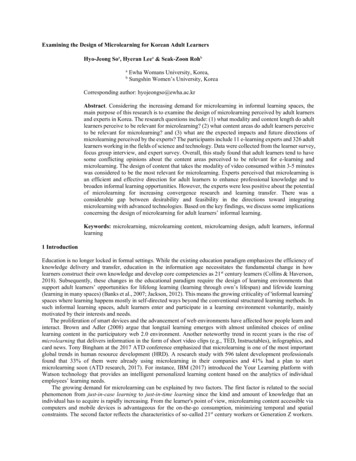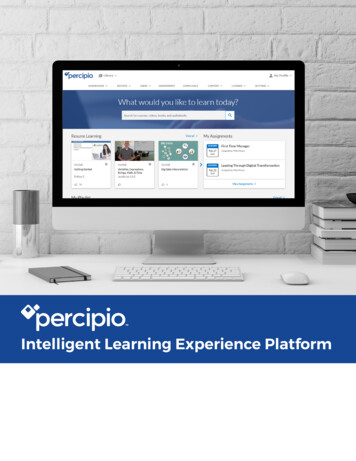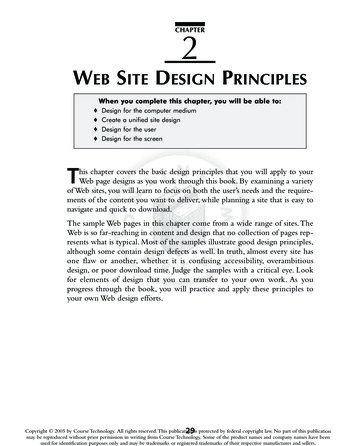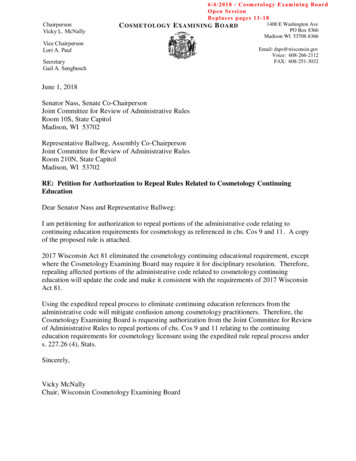
Transcription
Examining the Design of Microlearning for Korean Adult LearnersHyo-Jeong Soa, Hyeran Leea & Seak-Zoon RohbabEwha Womans University, Korea,Sungshin Women’s University, KoreaCorresponding author: hyojeongso@ewha.ac.krAbstract. Considering the increasing demand for microlearning in informal learning spaces, themain purpose of this research is to examine the design of microlearning perceived by adult learnersand experts in Korea. The research questions include: (1) what modality and content length do adultlearners perceive to be relevant for microlearning? (2) what content areas do adult learners perceiveto be relevant for microlearning? and (3) what are the expected impacts and future directions ofmicrolearning perceived by the experts? The participants include 11 e-learning experts and 326 adultlearners working in the fields of science and technology. Data were collected from the learner survey,focus group interview, and expert survey. Overall, this study found that adult learners tend to havesome conflicting opinions about the content areas perceived to be relevant for e-learning andmicrolearning. The design of content that takes the modality of video consumed within 3-5 minuteswas considered to be the most relevant for microlearning. Experts perceived that microlearning isan efficient and effective direction for adult learners to enhance professional knowledge and tobroaden informal learning opportunities. However, the experts were less positive about the potentialof microlearning for increasing convergence research and learning transfer. There was aconsiderable gap between desirability and feasibility in the directions toward integratingmicrolearning with advanced technologies. Based on the key findings, we discuss some implicationsconcerning the design of microlearning for adult learners’ informal learning.Keywords: microlearning, microlearning content, microlearning design, adult learners, informallearning1 IntroductionEducation is no longer locked in formal settings. While the existing education paradigm emphasizes the efficiency ofknowledge delivery and transfer, education in the information age necessitates the fundamental change in howlearners construct their own knowledge and develop core competencies as 21st century learners (Collins & Haverson,2018). Subsequently, these changes in the educational paradigm require the design of learning environments thatsupport adult learners’ opportunities for lifelong learning (learning through own’s lifespan) and lifewide learning(learning in many spaces) (Banks et al., 2007; Jackson, 2012). This means the growing criticality of 'informal learning'spaces where learning happens mostly in self-directed ways beyond the conventional structured learning methods. Insuch informal learning spaces, adult learners enter and participate in a learning environment voluntarily, mainlymotivated by their interests and needs.The proliferation of smart devices and the advancement of web environments have affected how people learn andinteract. Brown and Adler (2008) argue that longtail learning emerges with almost unlimited choices of onlinelearning content in the participatory web 2.0 environment. Another noteworthy trend in recent years is the rise ofmicrolearning that delivers information in the form of short video clips (e.g., TED, Instructables), infographics, andcard news. Tony Bingham at the 2017 ATD conference emphasized that microlearning is one of the most importantglobal trends in human resource development (HRD). A research study with 596 talent development professionalsfound that 33% of them were already using microlearning in their companies and 41% had a plan to startmicrolearning soon (ATD research, 2017). For instance, IBM (2017) introduced the Your Learning platform withWatson technology that provides an intelligent personalized learning content based on the analytics of individualemployees’ learning needs.The growing demand for microlearning can be explained by two factors. The first factor is related to the socialphenomenon from just-in-case learning to just-in-time learning since the kind and amount of knowledge that anindividual has to acquire is rapidly increasing. From the learner's point of view, microlearning content accessible viacomputers and mobile devices is advantageous for the on-the-go consumption, minimizing temporal and spatialconstraints. The second factor reflects the characteristics of so-called 21st century workers or Generation Z workers.
This new generation of workers is social and mobile. Microlearning is viewed as a way to bring their social andmobile behaviors into learning experiences.Despite such growing interests and demands toward microlearning, there is little empirical research availableabout how to design microlearning relevant for adult learners. Our previous review of the existing literature onmicrolearning indicates that little academic research studies had been conducted in this area (So & Lee, 2017). Weconducted a systematic literature review on the topic of microlearning published in the years from 2003 to 2017 andidentified 74 articles. Only 13 articles reported empirical findings, and the existing articles on microlearning weremostly about theoretical/conceptual discussions and technical development. Studies with empirical findings presentdata related to the effectiveness and benefits of microlearning (e.g., Hanshaw & Hanson, 2018; Leach & Hadi, 2017).Some information about the design of microlearning content and topic areas was available in these studies.Microlearning content types include various modalities such as video, audio, and visuals with concise information.Topic areas were also diverse, including economics, medical/health, language, and computer (refer to So & Lee, 2017for more details). On the whole, while some intervention-based studies exist, there is still a lack of research that caninform the design of microlearning, especially in the context of informal learning for adult learners.With this backdrop, the main purpose of this research is to examine the perception of adult learners and expertstoward the design of microlearning in order to draw design implications. This study was initiated with the assumptionthat microlearning is not simply truncated tiny information but is a stand-alone manageable content that carriesmeaningful information and knowledge on its own (Giurgiu, 2017; Hug, 2015). Another assumption behind this studyis that not all types of knowledge may be relevant for microlearning, and certain types of knowledge can be betterdesigned and delivered via microlearning (Enmerson & Berg, 2018; Fox, 2016). To this end, we conducted a researchstudy with e-learning experts and adult learners in the field of science and technology in Korea to examine thefollowing research questions: (1) what modality and content length do adult learners perceive to be relevant formicrolearning?; (2) what content areas do adult learners perceive to be relevant for microlearning?; and (3) what arethe expected impacts and future directions of microlearning perceived by the experts? These are the questions thatthis study aimed to answer, ultimately drawing implications and insights for the design of microlearning.2 Theoretical Background2.1 What Microlearning Is. Initially, the term microlearning appears in the literature of e-learning, which generallyrefers to the delivery of learning, training or education programs by electronic means (Li et al., 2009). In e-learning,various information and communication technologies (ICTs) are used to mediate both synchronous and asynchronousteaching and learning activities (Sangrà et al., 2012). As shown in Table 1, there are numerous definitions ofmicrolearning found in the existing literature. Generally, microlearning is the term that presents “an abbreviatedmanner of expression for all sorts of short-time learning activities with microcontent” (Hug, 2015, p.492). Hug (2005)also presents six dimensions of microlearning namely (1) time, (2) content, (3) curriculum, (4) process, (5) modality,and (6) learning type. Often, the term microlearning is interchangeably called bite-sized learning to emphasize thenature of small-sized content (Soh, 2017). There are more-technically oriented definitions of microlearning sincemicrolearning can be offered across web 2.0 technologies as well as traditional learning management systems(Grevtseva et al., 2017). For instance, Sánchez-Alonso et al. (2006) defined microlearning as an independent unitconnected to learning objects that are easy to reuse in various learning contexts. The common components ofmicrolearning are characterized in terms of small and short digital content that can be consumed in 10 minutes (e.g.,Shail, 2019; Torgerson & Iannone, 2019).Table 1. Various definitions of microlearning.Hug (2015)Jomah et. al (2016)Khurgin (2015)Shail (2019)Torgerson & Iannone (2019)An abbreviated manner of expression for all sorts of short-time learningactivities with microcontent.All about getting your eLearning in small doses, as tiny bursts of trainingmaterial that you can comprehend in a short time.What one has learned, in small, focused steps, ( ) self-contained, with itsown learning objective ( ) as short as possible but as extensive as necessary.Relatively small, focused learning units consisting of condensed learningactivities (usually one to 10 minutes), available on multiple devices.Any learning content that can be consumed in 10 minutes.
Despite increasing interest in microlearning, a few studies empirically analyzed the effects of microlearning.Overall, empirical studies generally reported that microlearning had positive effects on learning. Leach and Hadi(2017) conducted a study where MOOCs were designed with a modular approach as microlearning. Since theintention of many MOOC learners is not on completing the entire course, Leach and Hadi challenged the assumptionabout the linear completion of the entire course as ideal participation in MOOCs. Instead, they adopted modularMOOCs where learners can choose any unit to start with and complete courses flexibly. As microlearning, eachmodular unit was designed to include own learning goals, activities, and assessment. Learners were awarded a badgefor the completion of each unit. Hesse et al. (2019) investigated the effectiveness of microlearning on dairy workers.Participants were given three videos about tube feeding, bottle feeding, and colostrum quality for about 10 minuteswith a quiz. In the study, 64 employees took the questionnaire after taking microlearning training and 50 (78%) ofthem reported that their confidence in completing tasks increased after training. Fagerstrøm et al. (2017) examinedthe impact of microlearning developed as a mobile application with flip cards for training healthcare professionals inNorway. The study used a between-subjects design with a randomized selection that included two experimentalgroups and one control group. Two experimental groups used the mobile microlearning application whereas thecontrol group was given traditional training with lectures and workshops. A pretest and posttest comparison wereused to measure the knowledge gain concerning the use of coercion in working with mentally and sociallyhandicapped people, which was the main content of the mobile application. The level of knowledge gains in theexperimental groups was higher than that of the control group.In the Korean context, Ju and Chung (2018) investigated the moderating effects of microlearning on therelationship between change readiness and willingness to change, and on the relationship between change competencyand willingness to change among adult workers in the IT company. In this study, three different microlearningcontents were provided to the participants, and the participation in microlearning was voluntary. They found that theparticipation rates in microlearning did not have a meaningful mediation effect. They speculated that the situation ofthe company at the time of the study might influence the participants and thus could affect the research result. Jung(2019) conducted a research study about developing microlearning contents and verifying its effectiveness throughthe usability evaluation. The usability indicators consisted of effectiveness, aesthetics, efficiency, ease of use,component display strategies, contents and structure, and degree of immersion. The usability score of all indicatorsin the microlearning content was higher than that of the general learning content.2.2 Microlearning Design. Microlearning needs certain design considerations such as appropriate learning time,content type, and modality. Concerning the appropriate learning time, the ATD research (2017) found that learnerstend to perceive segments lasting for two to five minutes the most effective for learning. Microlearning is designedas small chunks of learning content that learners can easily access in specific moments such as time breaks or on themove (Gabrielli et al., 2006). While typical lessons in e-learning consist of an opening, presentation, exercises, andclosing, microlearning content may omit some elements to make small chunks of learning content (Jahnke et al.,2020). Microlearning content is also easily editable, applicable, and reusable in a form suitable for individual learner’sneeds (Polsani, 2003).Concerning what to teach through microlearning, the existing literature indicates that microlearning is appropriateunder certain learning conditions and activities. For instance, Fox (2016) contends that microlearning is inappropriatewhen students are learning something for the first time or complex knowledge and skills. Similarly, Jahnke et al. (2020)suggest that microlearning is appropriate when learning objectives focus on the level of “understanding” in theBloom’s taxonomy, and high-order thinking skills (e.g., deep analysis) is rather difficult to learn throughmicrolearning. Microlearning is used to activate prior knowledge and to reinforce learning experiences (Hanshaw &Hanson, 2018; Paul, 2016). Hence, microlearning is often designed as a follow-up or supplementary component ofthe large training program.There are few established principles and guidelines available for the design of microlearning. We could locate onlyone research that specifically discussed the design of microlearning content for mobiles. Drawn from the analysis ofthe literature and interviews with industry professionals, Jahnke et al. (2020) propose eight design principles of mobilemicrolearning: (1) interactive microcontent for closing practical skill gaps (e.g., practical problems), (2) chunkedcourses, (3) instructional flow of activity-based model of instruction (e.g., sequencing, instant feedback), (4) systemdesign (e.g., push notification, tracking), (5) supporting learner needs (e.g., the moment of need), (6) supporting socialstructures (e.g., connecting learners), (7) cost and affordable subscription model, and (8) curriculum that providessingle lessons and may lead to certificates or degrees. While these are useful design guidelines, they were mainlydrawn from the scholarly articles and expert opinions, and learners’ perceptions about these design aspects were notreflected.
Thus far, a video has been the most common modality of delivering microlearning content. The design ofmicrolearning, however, should go beyond small chunks of video clips and include strategies to engage learners indeeper learning processes (Major & Calandrino, 2018). Jahnke et al. (2020) contend that the design of microlearningcontent for mobile platforms and devices is “shifting from a pure video watching approach to a more activity-basedmodel of instruction in which the learner reads or watches something but then s/he has to be active to apply the newknowledge” (p.28). Gamification has been used to make the design of microlearning content more interactive (Ahmad,2018; Göschlberger & Bruck, 2017). However, designing microlearning with the integration of advanced types oftechnologies such as augmented reality (AR), virtual reality (VR), and artificial intelligence (AI) has not been activelyexplored in the existing literature. Considering the demand for customizable content driven by the increasing amountof new information and knowledge that adult learners need to learn, the affordances of more interactive and intelligenttechnologies need to be explored in the design of microlearning.3 Method3.1 Research Context and Participants. For this study, the research team collaborated with the governmentaffiliated agency hat is the main provider of e-learning courses for enhancing the knowledge base and capacity of thescience and technology workforce in Korea. At the time of the study, the agency was planning to develop amicrolearning platform to extend its e-learning service and to meet the demands of adult learners’ flexible learningopportunities. Further, the agency intended to establish a long-term plan toward providing courses about convergenceresearch skills and the integration of advanced technologies into the design of microlearning. Thus, the researchcontext provided a good opportunity to examine adult learners’ perceptions of microlearning. Table 2 presentsinformation about the participants and the data collection method for the respective research question.Table 2. Research questions and data collection.Research Questions (RQs)Data collection & Participants(1) What modality and content length do adult learners perceive to berelevant for microlearning?(2) What content areas do adult learners perceive to be relevant formicrolearning?(3) What are the expected impacts and future directions of microlearningperceived by the experts?Learner survey (N 326)Learner survey (N 326)Focus group interview (N 11)Expert survey (N 13)First, to investigate adult learners’ perceptions about modality, content length, and content areas relevant tomicrolearning (RQs 1 & 2), participants in the study were recruited from adult learners who had taken at least one ormore e-learning courses offered by the agency. Some courses (e.g., research ethics, lab safety) provided by this agencyare mandatory for graduate-level students and Research & Development (R&D) professionals working in the fieldsof science and technology in the government-affiliated R&D institutes in Korea. We gathered data through the learnersurvey and focus group interview. For the focus group interview, we selected 13 participants (9 males and 4 females)who completed two or more e-learning courses provided by the collaborating agency.Second, we examined the experts’ perceptions of the expected impact and future directions of microlearningthrough the survey (RQ3). Methods that involve experts (e.g., Delphi study, expert survey) are often used in theemerging field for generating diversified ideas, reaching a consensus on debatable issues, and making predictions onfuture trends (Sangrà et al., 2012). Since microlearning was a rather new field with uncertainly at the time of the study,we used the expert survey method to gather experts’ opinions about the expected impact of microlearning and howfuture microlearning could be designed with the integration with new technologies. Examining experts’ opinions wasalso helpful to set the desirable directions of the microlearning initiative for the agency that we worked with. Wedefined experts as people who had conducted and published academic research and/or those who had extensivepractical experiences that could inform the design of microlearning. Since microlearning was discussed under the elearning context at the time of the present study, we recruited experts who had been working mainly in the e-learningfield. Due to the difficulty of locating relevant experts, we used a snowball sampling approach for the recruitmentwhere we initially identified three experts with expertise in microlearning and then asked their recommendations forothers eligible to participate in this study. Each participant received the information about the background, purpose,and method of the study through the telephone, e-mail, or in-person communication before agreeing to participate in
the survey. The expert group included five experts who were university faculty members with extensive researchexperiences in e-learning, three from the government agencies that offer e-learning courses, and three from theindustry sectors who were in charge of their organization’s e-learning content development, including microlearning.3.2 Data Collection and Analysis. Methodologically, we used the mixed method approach (Cresswell, 2003) tocollect both quantitative and qualitative data from adult learners and experts. We chose the mixed method approachto hear the voice of our participants through the focus group interview (FGI) and open-ended responses as well as toidentify overall trends from a large number of participants through a survey. Generally, FGI is used as a research toolthat explores new perspectives on key issues (Vaughn et al., 1996). Since the topic of this research, microlearning,was relatively new at the time of the study, we selected FGI as a relevant method to hear learners’ perspectives aboutthe topic.3.2.1 Learner Survey. The survey was conducted with a focus on deriving the design of microlearning from thelearner's point of view. We designed the online survey that included questions about (a) the modality and contentlength of microlearning content (e.g., What is the most ideal media type of microlearning content?); and (b) thecontent areas perceived relevant to learn through microlearning (e.g., Which of the following R&D topics do youthink is relevant for microlearning?). A convenience sampling method was used to recruit participants for the survey.Through an exhaustive mailing list provided by the agency, an invitation to participate in the survey was sent out tothe learners who had taken at least one or more online course(s) from the e-learning platform provided by the agency.In the online survey, the participants read the statement about the purpose of the study, and those who agreed withthe statement moved to the next page to begin the survey. A total of 326 participants completed the online surveywith valid responses. Descriptive statistics were used to analyze the mean and standard deviations (SD) of responsesand rank orders.3.2.2 Focus Group Interview. The purpose of a focus group interview (FGI) was to further examine what and howadult learners perceive the design of microlearning, mainly from the content consumer’s perspectives. The FGI wasconducted in two separate sessions at a meeting room, facilitated by the research team. The FGI was conducted fortwo hours with semi-structured questions that focused on the relevant topics for microlearning such as exploringpotential topics, content properties, and content development. While various issues were discussed during the FGI,the present study focuses on the findings related to the content areas relevant to microlearning. The conversationduring the FGI was audio-recorded and transcribed for the content analysis. The transcripts were analyzed to findcommon themes in the interview conversations through the constant comparison method (Corbin & Strauss, 2015).Similar responses were grouped under conceptual headings to form categories and then core categories were identifiedas a major theme.3.2.3 Expert Survey. The main purpose of the expert survey was to gather experts’ perceptions of the expected impactof microlearning and the future directions of microlearning. The survey items were co-constructed with the e-learningpersonnel of the agency since the findings needed to inform the agency’s future planning of the microlearninginitiative such as the plan to provide courses about convergence research skills and the integration of advancedtechnologies into the design of microlearning. In the survey, we made it clear that adult learners in the statementsrefer to the R&D professionals in science and technology with some information (e.g., types of learners, learningmethods, range of courses offered, etc.) to help the experts to better understand the contextual factors.The first section of the study included the following five questions on a 5-point Likert scale (1 Strongly disagree,5 Strongly agree) concerning the expected impact of microlearning. Open-ended areas were provided in eachquestion for the experts to provide elaborations for their response.Q1: Microlearning will be effective in enhancing adult learners’ professional knowledge.Q2: Microlearning will be efficient in enhancing adult learners’ professional knowledge.Q3: Microlearning will enhance convergence research among adult learners.Q4: Microlearning will improve adult learners’ on-site application of learning (learning transfer).Q5: Microlearning will increase adult learners’ opportunities for informal learning.The second section of the study focused on the future directions of microlearning that will be provided to scienceand technology R&D professionals within the next five years. We provided the following five directions and askedthe experts to indicate the desirability and feasibility of each direction on a 5-point Likert scale (1 Strongly disagree,5 Strongly agree). In the decision-making theory, desirability refers to the value of the certain activity’s end-state
(e.g., this activity is valuable) whereas feasibility refers to the means of achieving the activity’s end-state (e.g., thisactivity is easy to implement) (Liberman & Trope, 1998). The interaction between desirability and feasibility leads toconflicting choices, particularly when a certain activity is perceived to be high desirability but low feasibility (HDLF) or low desirability but high feasibility (LD-HF) (Lu et al., 2013). By measuring both desirability and feasibilityfor the statements, we attempted to help the agency make a balanced choice for the future planning of the microlearninginitiative.Q1: The existing competency-oriented e-learning will be replaced by microlearning.Q2: Microlearning content produced and shared by learners will be pervasive.Q3: The provision of intelligent microlearning content, which analyzes the interests and needs of learners, willbecome more common.Q4: The form of microlearning content will be combined with new technologies such as virtual reality, augmentedreality, and the Internet of Things (IoT).Q5: The use of microlearning content will become common in both formal and informal learning spaces.The expert survey was distributed via email after the experts agreed on the research participation. Collected datawere analyzed for descriptive statistics, and responses to open-ended questions were content analyzed to identifyoverall patterns and common themes across the experts’ responses.4 Results4.1 Demographic Data. Table 3 shows the demographic data for the participants of this study. The participantsincluded more male learners (N 206, 63.2%) than female learners (N 120, 36.8%). About 67 % of the participantswere in their 30s (N 104, 31.9%) and 40s (N 115, 35.3%). About half of the participants (N 156, 47.9%) indicatedthat they work in the research sector. Concerning the job type and position, there were more researchers (N 215,66.0%) than administrative officers (N 111, 34.0%), and job positions were almost even across the entry, junior andsenior levels. About 68% indicated that they hold a master’s or doctorate degree, implying that the participants arehighly educated learners. Concerning their academic major, the largest number of participants were from the naturalscience and engineering areas (N 191, 58.6%), followed by humanities and social science (N 103, 31.6%). Insummary, the participants of this study were mostly researchers in their 30s and 40s with a master’s or doctoratedegree from the natural science and engineering fields who were engaged in research-related jobs.Table 3. Demographic data.VariableGenderAgeOrganizationJob typeCategoryMaleFemaleThe 20sThe 30sThe 40sover 50sIndustry sectorAcademic sectorResearch .315.018.134.047.9ResearcherAdministrative officer21511166.034.0VariableJob PositionFinal evelBachelorMaster’sDoctorateNatural science &EngineeringMedical fieldsHumanities & socialScienceOther .940.558.6211036.431.6113263.4100.04.2 Modality of Microlearning. First, we asked the question about the modality of microlearning content, both mediatype and ideal length. As presented in Table 4, video (64.4 %) was perceived to be the most relevant modality formicrolearning, followed by 21.5 % in visual images (e.g., cartoons, infographics), and 13.5% in the text (e.g., reports,news articles). Concerning the ideal length of microlearning content, as shown in Figure 1, the participants felt thatthe content length between 3-5 minutes is the most ideal for microlearning, followed by 7-10 minutes (28.2%) and 57 minutes (16.6%).
Table 4. Media type of microlearning content (N 326).Rank1234Media typeVideoVisual imagesTextOthers120N (%)210 (64.4)70 (21.5)44 (13.5)2 (0.6)101921008054602037334090Less than aminute1-3 mins.3-5 mins.5-7 mins.7-10 mins. More than 10mins.FrequencyFigure 1. Ideal length of microlearning content (N 326).4.3 Content Areas Relevant for Microlearning. In the learner survey, we examined the types of R&D topics theadult learners perceived the most relevant for microlearning. In this question, multiple responses were allowed. Table5 summarizes the top five-ranked topics. Overall, the data indicate that the participants perceived the needs ofmicrolearning in the topic areas that deal with the latest issues and are beneficial for their creative ideas. The needsof domain-specific topics that deal with deeper knowledge levels were perceived to be less relevant for microlearning.Table 5. Rank-order of
Hyo-Jeong Soa, Hyeran Leea & Seak-Zoon Rohb a Ewha Womans University, Korea, b Sungshin Women's University, Korea . The participants include 11 e-learning experts and 326 adult learners working in the fields of science and technology. Data were collected from the learner survey, focus group interview, and expert survey. .










